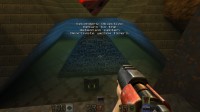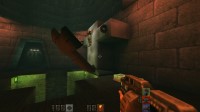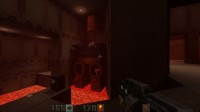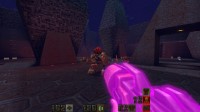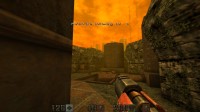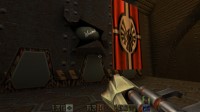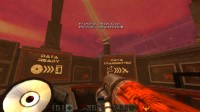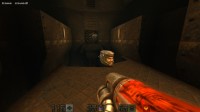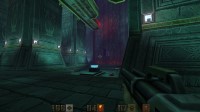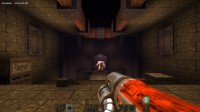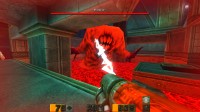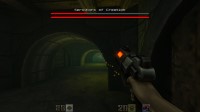Quake 2
TOTAL PLAYTIME: 28.9 Hours
Finished 04 August 2024.Played all of the campaigns available in the 2023 remaster of Q2, which includes the base game, the Quake 2 N64 port, the two original expansions (The Reckoning and Ground Zero) and the new campaign (Call of the Machine). Played all of them on Nightmare difficulty, which is (to my knowledge) the hardest baseline difficulty in the game before doing self-imposed challenges. Generally speaking though, I only really used powerups for boss fights.
Base Campaign: 8.1 Hours
I really didn't find this very difficult, which is kind of a surprise given that these games were fundamentally designed with mouselook in mind. This campaign generally felt very fair to me, maybe even a bit timid with enemy placement - there were several empty rooms that I felt like would have had some giant enemy clumps if this were any other old-school shooter.
Quake 2 N64: 2.7 Hours
Unlike the base game (and all of the other expansion campaigns), Q2 N64 is the one campaign that takes the design back to individual levels instead of units, most of them quite small - probably so that the N64 hardware could handle it without blowing up. Unfortunately, the design also inherited pretty much all of the other bad traits of old shooters - enemies constantly spawn behind you or on top of you for the express purpose of making you eat your own splash, or otherwise to force a damage-trade tanking battle which is pretty lame. Thankfully this was short enough to bust through without much effort. I guess it is cool that it's a separate thing though.
The Reckoning: 5.6 Hours
From what I know, the expansions seem to have a pretty mixed reputation. I thought TR was fairly solid throughout though - the new weapons (ion ripper and phalanx) were very fun and surprisingly not overpowered though the railgun still reigns. There were definitely a noticeable number of garbage spawns (just like Q2 N64) but I guess that's kind of par for the course when playing the expansions, as they are fundamentally designed to challenge people who have already played themselves sick of the base game and need more of a challenge. Introduced enemies were hit-or-miss; I particularly hated the absurd hitscan laser guards even if they didn't do much damage.
Ground Zero: 5.9 Hours
The other original expansion, which had a horrible reputation before some of the rebalancing updates made in the remaster. Namely, the wall turrets have aiming lasers now so you know where they are and what they're shooting at - a godsend given that they are tiny and blend into the environment very well. With the changes, I found GZ to be about as good as TR overall, not noticeable better or worse. One thing of particularly important note is the introduction of the medic commander, a ridiculously tanky mob that also infinitely spawns groups of enemies every 2-3 seconds. It's as horribly designed as it sounds, with every single encounter being absolutely miserable and unfun. The only saving grace is that there really aren't that many of them, but their inclusion to ANY extent kind of speaks to the rushed nature of the expansion - namely the complete lack of playtesting.
Call of the Machine: 6.6 Hours
This is like DotM/DoMa in the Q1 remaster, a set of 6 new mini-campaigns made by MachineGames staff exploring different campaign designs, with each one having a unique atmosphere differentiating itself from the rest. For example, in Corpse Run you start with the BFG and kill like 50 generic dudes in the first room; a good sign for the sheer carnage for the rest of that campaign. On the other hand, Ruined Earth and Darkest Depths have a creepier undertone, with the former filled with Mutants (reminiscent of Q1 fiends) and the latter culminating in a boss fight against 3 Shamblers from Q1 (spoilers!). Overall, the campaigns tended to be quite good though very tough - like DoMa, I believe this to be a very positive addition to the game. However, the final boss fight (after completing all of the sub-campaigns and passing through the gateway) is hilariously easy to cheese; I don't know if there wasn't an expectation that you wouldn't know how to rocket jump but both phases could effectively be bypassed just by camping in an unreachable corner and holding M1 with the blaster out until the bosses are all dead. Kind of a shame; having to actually right the 2 Mega-Shamblers without such a heavy crutch might be interesting, but that arena was too claustrophobic for me to care (and I was feeling quite tired of this game at that point).
Quake 2 has a very different overall feel than Quake 1 in pretty much every way, which is pretty indicative of the Quake series as a whole IMO. The weird, lovecraftian horror-inspired enemies and environments of Quake 1 are replaced by a gritty cyborg-empire in the Strogg, the movement system feels very different with particular regard to air control, and the level design ditches the compact individual stages to explore a new design by dividing the game into "Units" each comprised of multiple interconnected maps. It still gives off a heavy-metal, gritty and worn feel, yet doesn't tread the same ground as Q1. Personally, while I don't think I'm quite as big a fan of this as I was with Q1, this was still very well worth the time I spent in it.
The gameplay differences are the obvious first consideration; just like the Q1 remaster port, Q2 felt amazing to actually play with precise controls and responsive weaponry. The weapons each feel different yet each powerful enough to carve out their own niches, but as with any of these games the workhorse weapons are still the usual suspects; double-barrel shotgun, rockets, railgun. Because the Q2 levels place such a heavy emphasis on spamming hitscan threats everywhere, the rapid-fire weapons end up getting pushed out of the rotation. It really can't be overstated how useful the Railgun is in particular as it grants the player a very high-damage hitscan tool to mulch the game (which can clear out entire rows of enemies at once due to its infinite penetration); even the expansions pick up on the clear hierarchy and generally give the player the rocket launcher & railgun early on via secrets. Also, player control is very different from Quake 1 in one key area - the air control was changed, opening the way for a new "strafe-jumping" technique as opposed to the bhop of Q1. I believe this change was made since the bhop mechanic wasn't intended, and the fix in Q2 ended up introducing this other bug which is pretty funny. Instead of the A/D strafe familiar to any Source game players, this game requires a pretty awkward WA/WD 45-degree strafe and a strictly-positioned mouse angle, which rockets you through the hallways - albeit with far less turning control. I still don't like it as much as the classic bhop technique, but I started to get used to it as I played more.
Speaking of the enemies - I like how Nightmare difficulty primarily distinguishes itself beyond Hard mode by improving enemy AI, but it does seem a bit overtuned at times. Enemies can shoot or grab you pretty much instantly as you cross a corner with outlandish reaction times, making some of the poorer level design choices (spawns right behind you, etc.) an absolute misery to deal with; unavoidable damage in oldschool games almost feels like a cardinal sin. It's very clear that Q2 is sort of meant as a halfway point between the "dodge" and "tank" types of shooter games since it does shove quite a few health packs in your face to fill up whenever you take a chunk of hitscan damage or whatever, and I can't say I'm a fan of that. On the other hand, there are also some really cool behaviors added - as just one example, the grenade-launching cyborgs will actually continue to spam doorways and chokepoints where they last saw you to prevent cornerpeeking cheese strats.
I think the level progression was a particularly interesting departure from id's previous games and from most other contemporary shooters as a whole. The episodes of Doom, Quake 1, and countless other shooter games from that era were generally all standalone even if loosely connected to a persistent storyline, with weapons and gear being effectively reset between each campaign. Additionally, each level was generally entirely separate from the next, frequently with no consistency in theming or architecture to present any illusion of a larger world beyond the individual playgrounds made for each level. The design of Quake 2 puts forth much greater effort here, giving the player a single persistent & unbroken narrative throughout the entire game. Your character is a space marine that was part of a paratrooper campaign to destroy key facilities on the Strogg Homeworld to stop their advance on Earth (not entirely correct, but close enough). The game is instead broken up into "units" as previously mentioned, each one comprised of several maps that loosely model various locations - armories, factories, cloning facilities, etc. Instead of looking for an abstract "exit level" door, you're given realistic objectives throughout each unit as well - for example, sabotaging fuel lines or disrupting cloning machines. I think this game is overlooked for having this feature because of the release of Half-Life just one year later, which incorporated a fully-connected environment and a much more intricate plot, but I feel like this game has its own niche in between the abstract chaos of early FPSes and the linearized 2000s games.
In general, I think this game was very well worth playing though I don't really see myself revisiting it regularly - both due to the sheer size of my backlog (even if I only count similar old-school shooter games) and because the monotony of the game does really drag on, with hours and hours of dull metal corridors and the same enemy designs. I think Nightmare was absolutely the right choice of difficulty, even if there are some instances of absolute BS and poor enemy behaviors that don't exist on any of the lower difficulties.
